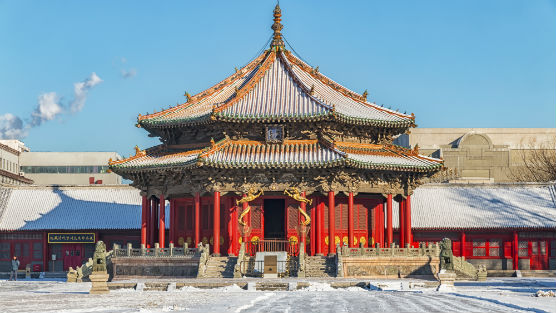Shenyang is the capital of Liaoning Province, the core city of Shenyang Economic Zone, the central city of the northeast, manufacturing base of advanced equipments, and the national historical and cultural city[1]. Shenyang lies in the northerly shore of Hun River, the ancient name of which was Shenshui, and was named Shenyang with the meaning of "sun side of Shenshui". The historical and cultural heritages are mainly that before the establishment of Qing Dynasty and that during the Republic of China. Shenyang was established as a city 2,300 years ago, and now, it has nine districts, one city, and three prefectures with the total area of 13,000 square kilometers and the urban area of 3,495 square kilometers.
Top
The climate belongs to the warm temperate zone with semi-humid moisture conditions. The continental climate appears significantly, belonging to the temperate monsoon climate with frost-free period of 183 days all the year round. Affected by monsoon, the rainfall is concentrated with large temperature difference and a clear distinction between the four seasons. The annual temperature fluctuates between -29℃ and -36℃, the summer average temperature is about 20℃ with the highest temperature reaching up to 36℃, the lowest temperature of winter can reach -30℃ with the average temperature of 8.3℃. The annual rainfall fluctuates between 680mm and 530mm, decreasing from southeast to northwest. The area between the city and the coastal area of Dongling Hun River is the high rainfall area and the northern Xinmin County is the dry area with the rainfall difference of about 150mm. Since 1906, the annual average rainfall in the city was 715.5mm, more than that of the western Liaoning and less than that of the eastern mountain area; approximately 50% more than that of Chaoyang, but 30% less than that of Dandong. The rainfalls of most years are relatively appropriate.
Top
1. Shenyang Imperial Palace
The Shenyang Imperial Palace is located in the Shenhe district of Shenyang city and the center of the old city of the Ming and Qing Dynasties. The Shenyang (Shengjing) Imperial Palace before the Later Jin Dynasty and the Mukden Palace after the Qing Dynasty moved to Beijing were first established in 1625 and completed in 1636. It had also undergone a large-scale reconstruction and upgrading during QianLong period covering an area of about 60,000 square meters. After 1926, its architectural complex was turned into museums (the present Shenyang Imperial Palace Museum) in succession. In 1961, it was identified as one of the first batch of key national cultural relics units under protection by the State Council of the People's Republic of China, and in July, 2004, it was listed in the "Beijing and Shenyang Imperial Palaces of Ming and Qing Dynasties" project of the "world heritage list".

2. The Tawan Stupa
The Tawan Stupa was established in 1044 (Liao Chung-Shi thirteenth year) and was reconstructed in the sixth year of Emperor Chongde of Qing Dynasty. As it stores 1,548 "sarira", it is also known as the Tawan Stupa. The Tawan Stupa, which is located at No.15, Lane 45, Tawan Street, Huanggu district, the northwest of Shenyang, is magnificent with a long history, and its view has never diminished a bit since ancient times.

Top
The bus lines of the urban district in operation have reached more than 300 accompanied by the service of overnight bus. Buses in the urban district adopt the self-service ticketing system with the uniform fare of the majority of 1 Yuan. The suburban buses adopt the segmenting charge mode.
Top
The ticket price from Shenyang Taoxian International Airport to Maluwan Civil Aviation Ticket Office in No. 117, Zhonghua Road is 15 Yuan with a 40 minutes of bus trip, starting as soon as the arrival of flight. During the trip, it stops at the TV station (exhibition hall). Travelers from Fushun can choose to take the intra-city civil aviation regular bus with the ticket price being 33 Yuan (including fuel surcharge). The bus station is located at No.2, Dongyi Road (not far from the east of the Hotel).
Top


